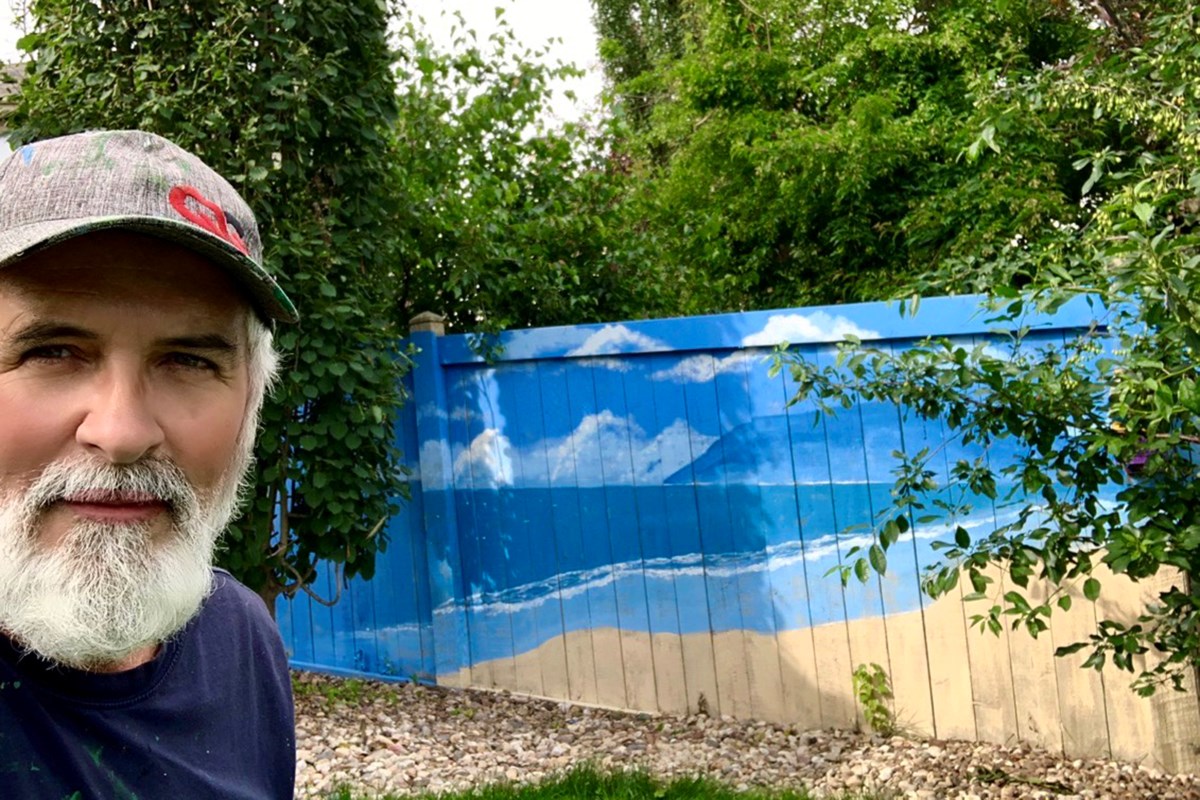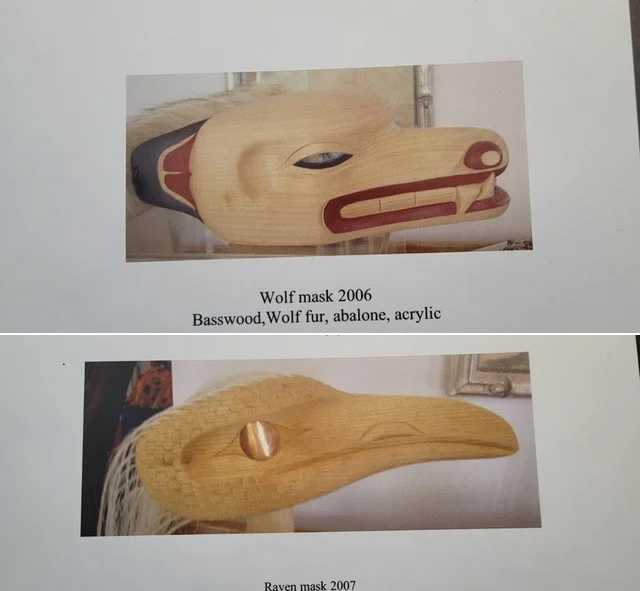Art
Morinville muralist paints fence art – St. Albert Today


From 50,000-year-old cave dwellers to 21st-century graffiti artists, murals have given humans a way to express their world for centuries.
Closer to home, this popular art form has found its way on all sorts of exterior walls including garages, sheds and fences.
Morinville visual artist Robert Murray is one the latest to dive into this populist art form. His fence landscapes, mountainscapes and seascapes may not decorate great halls, however, they create a serene, relaxing environment for the homeowner.
Murray turns an ordinary wall into an extraordinary scene. His nature-based garden art runs the gamut, from a tree grove surrounding a cool pond or a ship sailing on orange waters during a setting sun, to water mills turning alongside rushing rivers or a lighthouse on a cliff waiting for the tide to rise.
“When I first posted my fence work on St. Albert Chat, my Facebook page lit up with inquiries. With people staying home because of COVID, I’ve already completed 65 since April,” said Murray.
Originally from Nova Scotia, he showed an aptitude for drawing at an early age. After high school, Murray travelled to Red Deer College where he graduated from a two-year art and design program.
“It covered a broad spectrum of art. My first intention was to be an art teacher to young children.”
However, as a member of the Church of Jesus Christ of Latter-day Saints, Murray was called to serve as a missionary in England. Across the pond, he discovered the French impressionists. In particular, Édouard Manet and Claude Monet art had a profound influence on the young Canadian.
“The impressionists immediately struck a chord, and I was trying to use their technique. I admired their skill, the loose compositions and the romance in the paintings.”
Upon returning to Alberta, he met his wife Judy. They were married shortly after and had five children, all gifted with artistic talent.
Raising a family required different commitments. Murray pivoted to sales for 42 years, selling life insurance first and then industrial materials to oil and gas companies.
In the 1990s, his creative juices started flowing once more as he published three books, and for a time, sketched a weekly cartoon strip. He also designed a series of t-shirts as well as painted detailed landscapes on rocks and stones later sold at the St. Albert Farmers’ Market.
“I really honed my palette of colour and light and shadow in painting rocks.”
Through a series of circumstances, Murray inadvertently began mural painting after his mother was admitted to a seniors centre.
“I went to visit her and one day I was staring at a bare wall. I asked permission if I could paint a mural. It was an organic fantasy in the Kincaid style with flowers, trees and leaves.”
The administration loved his concept and commissioned two more works. To date, the prolific muralist has completed 500 pieces.
From painting three-pound rocks to finding himself on a hydraulic lift painting images more than three stories high, Murray has developed a style that incorporates impressionism’s romantic vibe.
“When I get a brush in my hand, I’m lost in my world and I love it. It’s a wonderful thrill. For me, it’s therapeutic.”
Murray works with speed and agility completing as many as two fence art pieces a day. In between painting garden art, he’s also been commissioned to create 13 indoor murals for Alberta hospitals.
“My plan is to make the murals a place of tranquility and peace that helps them (patients) reflect on the things that bring them happiness.”
As for the backyard fence art, he said, “With COVID-19 going the way it is, I want to leave people with a piece of heaven.”
Art
Enter the uncanny valley: New exhibition mixes AI and art photography – Euronews
In 2023, Boris Eldagsen revealed that he won a prestigious photography award by submitting an AI-generated image. Now, a London gallery is putting on an exhibition of his work to demonstrate the power of AI in art.
Not long after the Sony World Photography Award Creative Category winner was announced last year, the victor came clean with a surprising revelation. German photographer Boris Eldagsen admitted that his first prize-winning photograph ‘The Electrician’ was actually an AI-generated image.
Eldagsen had created the image using the popular AI-image creating tool DALL-E 2. He turned down the prize, citing his motivation for entering to see if “competitions are prepared for AI images. They are not.”
A year on from his famous refusal, the Palmer Gallery in London is hosting an exhibition of his and other artists’ works to demonstrate the ways art and AI are being used together.
‘Post-Photography: The Uncanny Valley’ features the works of Eldagsen alongside artists Nouf Aljowaysir and Ben Millar Cole. Eldagsen is exhibiting ‘The Electrician’ as part of a series of photography works that blend natural imagery with the synthetic.
Saudi-born and New York-based artist and design technologist Aljowaysir has examined the biases in AI-image creation in her work Ana Min Wein: Where am I from?, to recover her Saudi Arabian and Iraqi lineage from more the stereotypes AI tools rely upon.
British artist Millar Cole’s work toys with the now-publicly understood telltale signs of AI-doctored images and blurs that line with more sophisticated imagery, to create an uncannily off image.
“The artists in the exhibition engage with the current possibilities of creative collaboration with AI tools, harnessing the unique affordances brought on by the various technologies, whilst thinking about their implications,” says AI-art curator Luba Elliott.
“Image recognition tools highlight the imperfection of the machine gaze, whereas photorealistic text-to-image models focus on portraying our collective imagination down to the smallest detail, with the prompt engineer at the steering wheel – taking the viewer to the next stage of art history,” Elliott continues.
The term “uncanny valley” was first invented in 1970 by Japanese robotics professor Masahiro Mori. He described it as the way that humans will increasingly empathise with anthropomorphous-robots until a threshold when they become too humanlike and we find them unsettling.
As a concept, the uncanny was popularised by psychologists Ernst Jentsch and Sigmund Freud in their description of how familiar things can become strange when they present themselves as a facsimile of another part of ordinary life – they used dolls as a primary example.
The case against
While the Palmer Gallery is embracing a dialogue between AI and contemporary artists, other artists have been less willing to engage with the controversial technology.
Earlier this month, over 200 musicians signed an open letter from Artist Rights Alliance calling on artificial intelligence tech companies, developers, platforms, digital music services and platforms to stop using AI “to infringe upon and devalue the rights of human artists.”
Signatories of the letter included: Stevie Wonder, Robert Smith, Billie Eilish, Nicki Minaj, R.E.M., Peter Frampton, Jon Batiste, Katy Perry, Sheryl Crow, Smokey Robinson, and the estates of Bob Marley and Frank Sinatra.
While the full letter did acknowledge the value that AI could bring to areas of art, it was primarily concerned with the way non-creatives will rely on these nascent tools to further undermine the value of human creativity.
“Unchecked, AI will set in motion a race to the bottom that will degrade the value of our work and prevent us from being fairly compensated for it,” the letter writes. “This assault on human creativity must be stopped. We must protect against the predatory use of AI to steal professional artists’ voices and likenesses, violate creators’ rights, and destroy the music ecosystem.”
Similarly, Australian musician Nick Cave has spoken out against AI’s influence on art. When sent the lyrics to a ChatGPT generated impression of his work, he responded vociferously.
“Songs arise out of suffering, by which I mean they are predicated upon the complex, internal human struggle of creation and, well, as far as I know, algorithms don’t feel. Data doesn’t suffer. ChatGPT has no inner being, it has been nowhere, it has endured nothing, it has not had the audacity to reach beyond its limitations, and hence it doesn’t have the capacity for a shared transcendent experience, as it has no limitations from which to transcend.”
“ChatGPT’s melancholy role is that it is destined to imitate and can never have an authentic human experience, no matter how devalued and inconsequential the human experience may in time become,” Cave said.
During last year’s Writers Guild of America (WGA) strike that demanded restrictions on the use of AI to replace creative work, I also wrote against the over-valuation of AI’s talents: “The real human experiences that inspire art is what makes us fall in love with them. AI may be increasingly accurate at capturing an artist’s aesthetic, but that’s only skin-deep. It may be a useful tool for many aspects of an artist’s career, but it could never replace an artist entirely.”
Art
First Nations art worth $60K stolen in Saanich, B.C. | CTV News – CTV News Vancouver
A large collection of First Nations art worth more than $60,000 was stolen in Saanich earlier this month, police announced Thursday.
The Saanich Police Department said in a statement that the art was taken from a residence in Gordon Head on April 2.
“The collection includes several pieces by First Nations artist Calvin Moreberg as well as Inuit carvings that are estimated to be over 60 years old,” the statement reads.
Photos of several of the stolen pieces were included in the news release. Police did not elaborate on how or at what time of day they believe the art was stolen, nor did they say why they waited more than two weeks to issue an appeal to the public for help finding it.
Anyone who has seen the missing art pieces or has information related to the investigation should call Saanich police at 250-475-4321 or email majorcrime@saanichpolice.ca, police said.


Art
Art in Bloom returns – CTV News Winnipeg
-



 Investment18 hours ago
Investment18 hours agoUK Mulls New Curbs on Outbound Investment Over Security Risks – BNN Bloomberg
-



 Sports17 hours ago
Sports17 hours agoAuston Matthews denied 70th goal as depleted Leafs lose last regular-season game – Toronto Sun
-
Business15 hours ago
BC short-term rental rules take effect May 1 – CityNews Vancouver
-
Art15 hours ago
Collection of First Nations art stolen from Gordon Head home – Times Colonist
-



 Investment15 hours ago
Investment15 hours agoBenjamin Bergen: Why would anyone invest in Canada now? – National Post
-



 Tech18 hours ago
Tech18 hours agoSave $700 Off This 4K Projector at Amazon While You Still Can – CNET
-



 Tech17 hours ago
Tech17 hours ago'Kingdom Come: Deliverance II' Revealed In Epic New Trailer And It Looks Incredible – Forbes
-



 Science18 hours ago
Science18 hours agoJeremy Hansen – The Canadian Encyclopedia






